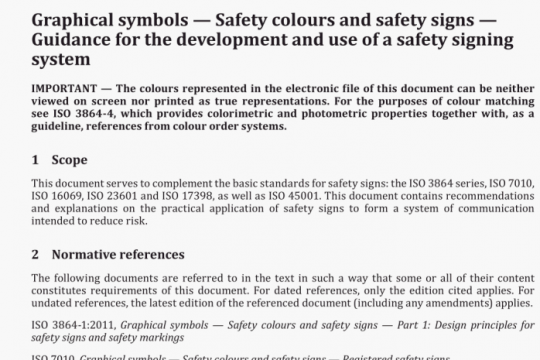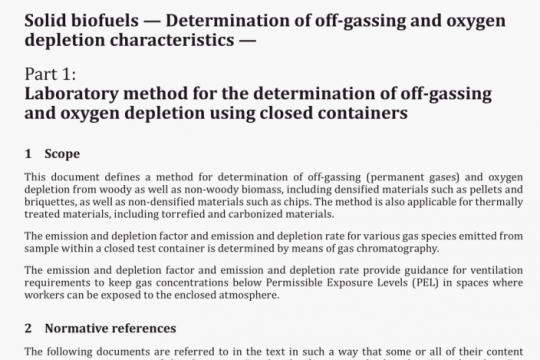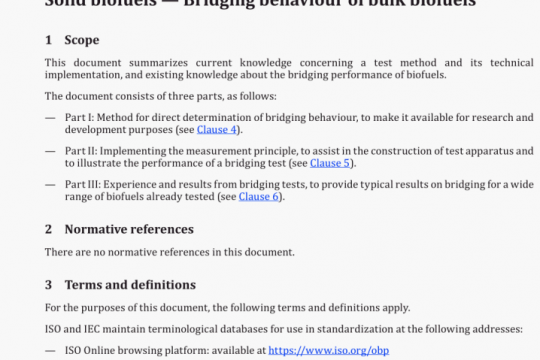ISO 6505 pdf free download
ISO 6505-2021 pdf free download.Rubber, vulcanized or thermoplastic一Determination of tendency to adhere to and corrode metals.
11 Procedure
11.1 Precaution
In all operations. it is essential tnat the ruooer test pieces and the metal test strips are handiea only oy means of the polyethylene gloves or other protective equipment (see 6A). This precaution is essential In order to minimize surface contamination of the test piece and metal strips.
11.2 Preparation of rubber test pieces for testing
Clean all the surfaces of the rubber test pieces with cotton wool pads moistened with a suitable solvent (see £2) to remove surface contamination (by mould release agents, for example). The solvent to be used will depend on the rubber under test; it shall not have any deleterious effects on the rubber (e.g. acetone should not be used for nitrile rubber; isopropyl alcohol is preferred for this material).
Allow the test pieces to dry in air. When dry, store the test pieces, unless otherwise specified, in a
clean desiccator over silica gel at standard laboratory temperature (see ISO 23529) for at least 24 h
immediately prior to testing.
Since cleaning of the test pieces might also remove from the rubber surface materials such as waxes, antiozonants, etc., which would normally be expected to affect the adhesion and corrosion properties of the rubber, allow sufficient time in the desiccator for the re-formation of the original” surface before testing.
11.3 Number of metal test strips
For each test, use two suitable metal test strips as specified in the material specification or selected from the metals specified in Clause 7.
For tests in a wet atmosphere, use only one type of metal in the construction of the test piece sandwichw in order to avoid electrolytic effects.
11.4 Preparation of surfaces of metal test strips
Thoroughly scour the test surfaces of the metal test strips using a slurry of pumice powder (Ii) in water applied with a cotton wool pad until a matt surface is obtained. Thoroughly rinse the metal strips with water (SA) and then with acetone (5,1) and finally dry in air. If the prepared metal test strips are not to be used immediately after cleaning, store them in a clean desiccator over silica gel for not more than 24 h before testing.
11.5 Determination
11.5.1 Tests in a dry atmosphere
11.5.1.1 Tests using sheet material (square test pieces)
Take two rubber test pieces as specified in 9.1.1, prepared as specified in iLL and two metal strips of dimensions 25 mm by 100 mm, prepared as specified in 11.4. Place the two pieces of rubber between the prepared surfaces of the metal strips so that they are approximately 40 mm apart and equidistant from the ends (see Figure 1). Align the rubber/metal sandwich so formed in the support jig and apply a (10 ± 0,1) kg weight (equivalent to 122,5 kPa acting on the rubber) to the test piece sandwich. Tighten the two screws, one at each end of the sandwich, with just sufficient force to maintain the clamping force when the 10 kg weight is removed. Remove the 10 kg weight from the jig, place the sandwich in the test chamber (.3) and maintain it at the test temperature for the test period (see Clause 10).
At the end of the test period, remove the sandwich from the test chamber, allow to cool, if appropriate, to standard laboratory temperature and maintain it at this temperature for at least 1 h. Release the screw clamps and carefully separate the metal strips from the rubber test pieces. Examine the surface of the metal previously in contact with the rubber for signs of adhesion and corrosion. Use a magnifying glass (6.5) in examining for corrosion.
11.5.1.2 Tests using 0-rings
Take two 0-rings of the same size, as specified in 9J…2. prepared as specified in 112 and two metal strips of dimensions 50 mm by 100 mm, prepared as specified in 11.4. Place the 0-rings between the prepared surfaces of the metal strips so that they are approximately 40 mm apart and approximately equidistant from the ends of the metal strips. Align the metal/rubber sandwich so formed in the support jig and apply a load L in accordance with Table 2 to the test piece sandwich. Tighten the two screw clamps, one at each end of the sandwich, with just sufficient force to maintain the clamping force when the load is removed. Remove the load from the jig, place the sandwich in the test chamber (6.3) and maintain it at the test temperature for the test period (see Clause 10).
At the end of the test period, remove the sandwich from the test chamber, allow to cool, if appropriate, to standard laboratory temperature and maintain it at this temperature for at least 1 h. Release the screw clamps and carefully separate the metal strips from the rubber 0-rings. Examine the surface of the metal previously in contact with the rubber for signs of adhesion and corrosion. Use a magnifying glass (6.5) in examining for corrosion.
11.5.2 Tests in a wet atmosphere
11.5.2.1 Tests using sheet material (square test pieces)
Take two rubber test pieces as specified in 9.1.1. prepared as specified in 11.2. and two metal strips of dimensions 50 mm by 100 mm, prepared as specified in 11.4. Place the two pieces of rubber between the prepared surfaces of the metal strips so that they are approximately 40 mm apart and equidistant from the ends (see Figure 1). Align the rubber/metal sandwich so formed in the support jig and apply a (10 ± 0,1) kg weight (equivalent to 122,5 kPa acting on the rubber) to the test piece sandwich. Tighten the two screws, one at each end of the sandwich, with just sufficient force to maintain the clamping force when the 10 kg weight is removed. Remove the 10 kg weight from the jig, place the sandwich in the test chamber (6.3) and maintain it at the standard laboratory temperature and a relative humidity of (90 ± 5) % for the test period (see 10.2).
At the end of the test period, remove the sandwich from the test chamber, release the screw clamps and carefully separate the metal strips from the rubber test pieces. Keep the metal strips in an atmosphere at standard laboratory temperature and a relative humidity of (50 ± 5) % for 16 h to 24 h. At the end of this period, examine the surface of the metal previously in contact with the rubber for signs of adhesion and corrosion. Use a magnifying glass (6.5) in examining for corrosion.
11.5.2.2 Tests using 0-rings
Take two 0-rings of the same size, as specified in 9.1.2. prepared as specified in 11.2, and two metal strips of dimensions 50 mm by 100 mm, prepared as specified in 1.1.4. Place the 0-rings between the prepared surfaces of the metal strips so that they are approximately 40 mm apart and approximately equidistant from the ends of the metal strips. Align the metal/rubber sandwich so formed in the support jig and apply a load L in accordance with Tabk2 to the test piece sandwich. Tighten the two screw clamps, one at each end of the sandwich, with just sufficient force to maintain the clamping force when the load is removed. Remove the load from the jig and place the sandwich in the test chamber (6.3) and maintain it at the standard laboratory temperature and a relative humidity of (90 ± 5) % for the test period (see 102).
At the end of the test period, remove the sandwich from the test chamber, release the screw clamps and carefully separate the metal strips from the rubber 0-rings. Keep the metal strips in an atmosphere at standard laboratory temperature and a relative humidity of (50 ± 5) % for 16 h to 24 h. At the end of this period, examine the surface of the metal previously in contact with the rubber for signs of adhesion and corrosion. Use a magnifying glass (6.5) in examining for corrosion.ISO 6505 pdf download.




